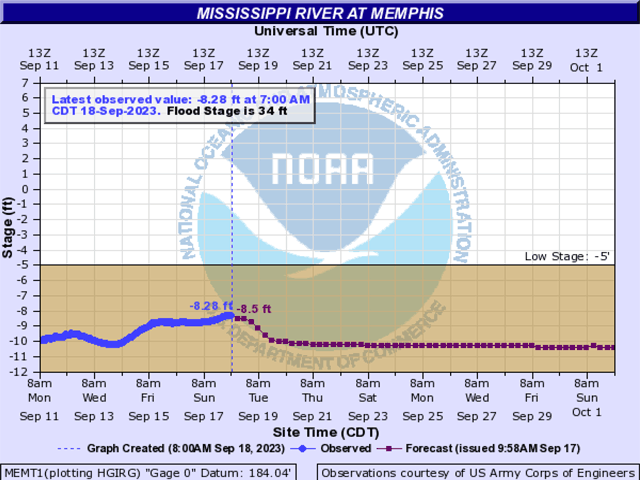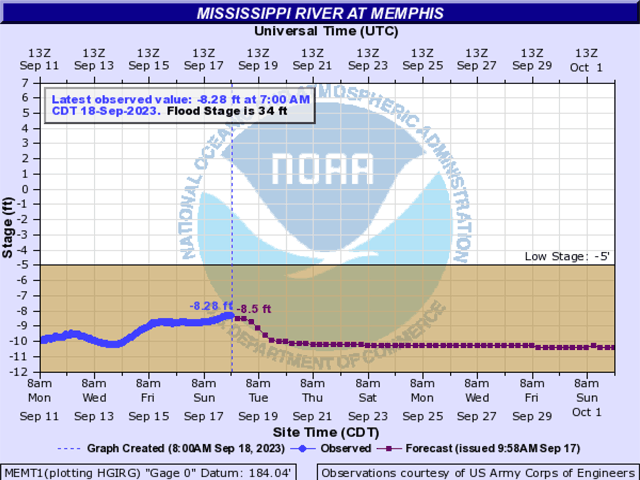Market Matters Blog
High Barge Freight, Low River Levels Detrimental to Farmers at Harvest
For the second year in a row at harvest time, low water levels on the Lower Mississippi River and tributaries are causing a big headache for shippers and also farmers who rely on river terminals to haul their new crop. In turn, barge freight costs are rising, having a negative effect on what farmers are paid for their crop.
"When you have the prospect of a given volume of freight (soybeans and grain, in the case of agriculture) that needs to be accommodated by a supply chain with reduced capacity, a natural result is an increase in the cost of that supply chain. We are certainly witnessing this with barge freight rates," Mike Steenhoek, executive director of the Soy Transportation Coalition, stated in an email to DTN. "One of the realities in agriculture is that many of these costs are disproportionately passed onto farmer in the form of a wider (i.e. more negative) basis. This macro issue of low water conditions on the Mississippi River has a local impact on an individual farmer's wallet."
How much of an impact? If you take the offer quoted last week of 950% and use the benchmark rate of $3.14 for the Cairo-Memphis corridor, the cost would be $29.83 per short ton. Then divide that cost per ton by 2000 (one short ton is equal to 2000 pounds) and multiply by 56 pounds for corn and the cost is 83 cents per bushel and 89 cents per bushel for soybeans (60 pounds.) The farther upriver of course, the higher the benchmark tariff.
On top of that, given the extreme low water in spots, barge drafts have been cut. A normal draft, the distance between the waterline and the deepest point of the boat, for a barge when river conditions are good is about 12 feet at 1,500 tons. On the Illinois River, barges are regularly loaded to about a 9-foot draft at 900 tons. Each foot of draft that is reduced means a barge's cargo is cut by 200 tons and will cost shippers money as they are paying the same amount of freight to ship less. In addition, that will create the need for more barges to pick up the slack.
American Commercial Barge Line stated on its website last week "St. Louis loading drafts reduced, approx. 15% below normal capacity. The Illinois and Mid-Miss continue to see approx. 15% reduction in loading draft. Tow size has been reduced to four widths Saint Louis to Cairo. Due to the current river stage and operating conditions, ACBL implemented draft and tow-size restrictions working in conjunction with USCG and Industry.
P[L1] D[0x0] M[300x250] OOP[F] ADUNIT[] T[]
"Loading drafts remain 20% reduced northbound Gulf to Cairo; 20% reduction SBD Cairo to Gulf. Note 16% reduction southbound from Lake Providence to the Gulf. Tow size is limited to six-widths from Cairo to the Gulf, reflecting a 17-25% reduction in tow size pending horsepower class. There are various segments reported with a 9-foot channel as further groundings occur. Expect delay to transit of 24-to-48 hours due to reduced navigable space in certain areas."
Ceres Consulting noted on Sept. 14 and 15 that "Shippers are booking nearby timings and on station equipment. Everyone is fighting through the delays, shallow drafts, and pushing to get every ton loaded to the Gulf before further restrictions. Where it matters most, the river stages continue to fall. Without additional water we may see record low river stages in back-to-back years. There is some rain late in the 10-day forecast; hopefully enough gets to the river to give some relief. Dredges finishing up in one problem spot will move right on to the next as there is no lack shallow spots right now."
Ceres added, "Mississippi River at Memphis stage remains flat in the extended forecast, no better/no worse currently so it doesn't look like the forecasted rain will have any impact on the river."
Mississippi River at St. Louis hydrograph: https://water.weather.gov/…
Ohio River at Cairo hydrograph: https://water.weather.gov/…
Mississippi River at Memphis hydrograph: https://water.weather.gov/…
Explanation of barge freight rates: https://www.ams.usda.gov/…
DTN story "Dredges Keep US River System Safe, Reliable" https://www.dtnpf.com/…
Mary Kennedy can be reached at mary.kennedy@dtn.com
Follow her on X, formerly known as Twitter, @MaryCKenn
(c) Copyright 2023 DTN, LLC. All rights reserved.






Comments
To comment, please Log In or Join our Community .